LG Electronics USA D285G Cellular/PCS GSM/EDGE/WCDMA Phone with WLAN and Bluetooth User Manual 1
LG Electronics MobileComm USA, Inc. Cellular/PCS GSM/EDGE/WCDMA Phone with WLAN and Bluetooth Users Manual 1
Contents
- 1. Users Manual 1
- 2. Users Manual 2
- 3. Users Manual 3
Users Manual 1

ENGLISH
User Guide
LG-D285g
MFL00000000 (1.0) www.lg.com
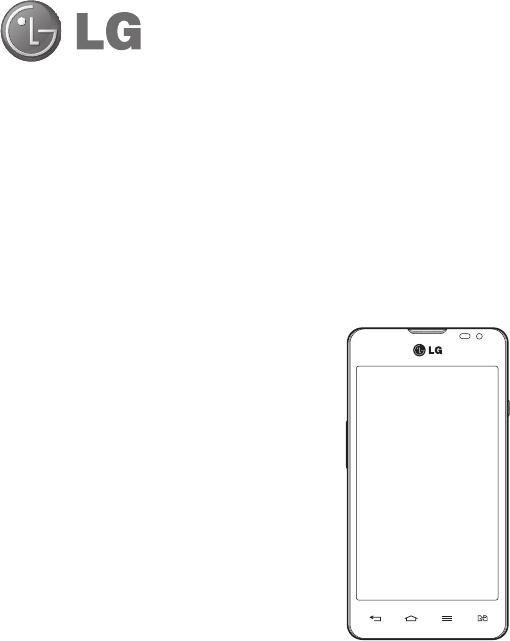
User Guide
• Screen displays and illustrations may differ from those you see on
actual phone.
• Some of the contents of this guide may not apply to your
phone, depending on the software and your service provider. All
information in this document is subject to change without notice.
• This handset is not suitable for people who have a visual
impairment due to the tap screen keyboard.
• Copyright ©2014 LG Electronics, Inc. All rights reserved. LG and
the LG logo are registered trademarks of LG Group and its related
entities. All other trademarks are the property of their respective
owners.
• Google™, Google Maps™, Gmail™, YouTube™, Hangouts™ and
Play Store™ are trademarks of Google, Inc.
ENGLISH

2
Table of contents
For your safety ....................................................5
Safety instructions ...........................................11
Important notice ...............................................18
Getting to know your phone .............................23
Phone overview ...............................................23
Charging your phone .......................................27
Using the memory card ...................................28
Locking and unlocking the screen ...................29
Knock Code .....................................................30
KnockON .........................................................30
Plug & Pop ......................................................30
Your Home screen .............................................31
Touch screen tips ............................................31
Home screen ...................................................31
Extended home screen ..................................32
Customizing the Home screen .......................33
Returning to recently-used applications...........33
Notifications panel...........................................34
Using Dual SIM ................................................34
Opening the notifications panel ......................35
Indicator icons on the Status Bar....................35
On-screen keyboard ........................................37
Entering accented letters ...............................37
Google account setup .......................................38
Connecting to Networks and Devices ..............39
Wi-Fi ...............................................................39
Connecting to Wi-Fi networks ........................39
Turning Wi-Fi on and connecting to a Wi-Fi
network ........................................................39
Bluetooth ........................................................40
Sharing your phone's data connection .............41
Wi-Fi Direct .....................................................42
PC connections with a USB cable ....................42
Calls ..................................................................44
Making a call ..................................................44
Calling your contacts .......................................44
Answering and rejecting a call.........................44
Adjusting the in-call volume ............................44
Making a second call ......................................45
Viewing your call logs ......................................45
Call settings ....................................................45
Contacts ............................................................46
Searching for a contact ...................................46
Adding a new contact ......................................46
Favourites contacts .........................................46
Creating a group .............................................47
Messaging .........................................................48
Sending a message .........................................48
Threaded box .................................................49
Changing your message settings .....................49
E-mail ................................................................50
Managing an email account ............................50
Working with account folders ..........................50
Composing and sending email .........................50
Camera ..............................................................51
Getting to know the viewfinder ........................51
Using the advanced settings ............................52
Taking a quick photo ......................................53
Once you've taken a photo ..............................54
From your Gallery ............................................55

3
Video camera ....................................................56
Getting to know the viewfinder ........................56
Using the advanced settings ............................57
Recording a quick video ..................................57
After recording a video ....................................58
From your Gallery ............................................58
Adjusting the volume when viewing a video ....58
Function ............................................................59
QuickMemo .....................................................59
Using the QuickMemo options .......................60
Viewing the saved QuickMemo .....................60
QSlide .............................................................61
LG SmartWorld ................................................62
How to Get to LG SmartWorld from Your
Phone ..........................................................62
How to use LG SmartWorld ............................62
Multimedia ........................................................63
Gallery ............................................................63
Viewing pictures ...........................................63
Playing videos...............................................63
Editing photos ...............................................63
Deleting photos/videos ..................................63
Setting as wallpaper ......................................64
Videos .............................................................64
Playing a video .............................................64
Music ..............................................................65
Playing a song ..............................................65
Add music files to your phone ........................67
Transfer music using Media sync (MTP)..........67
FM radio .........................................................68
Utilities ..............................................................69
Guest Mode ...................................................69
Setting your alarm ...........................................69
Using your calculator .......................................69
Adding an event to your calendar ....................70
Voice Recorder ................................................70
Recording a sound or voice ...........................70
Task Manager .................................................70
Tasks ..............................................................71
ThinkFree Viewer .............................................71
Google+ ..........................................................71
Voice Search ...................................................72
Downloads ......................................................72
The Web ............................................................73
Internet ...........................................................73
Using the Web toolbar ...................................73
Viewing webpages ........................................73
Opening a page ............................................73
Searching the web by voice ...........................73
Bookmarks ...................................................74
History .........................................................74
Chrome ...........................................................74
Viewing webpages ........................................74
Opening a page ............................................74
Syncing with other devices ............................74
Settings .............................................................75
Networks ........................................................75
Sound .............................................................77
Display ............................................................78
General ...........................................................79
PC software (LG PC Suite) ................................83
Phone software update ....................................85
Phone software update....................................85

4
About this user guide .......................................86
About this user guide ......................................86
Trademarks .....................................................86
Accessories .......................................................87
Troubleshooting ................................................88
FAQ ....................................................................91
Table of contents
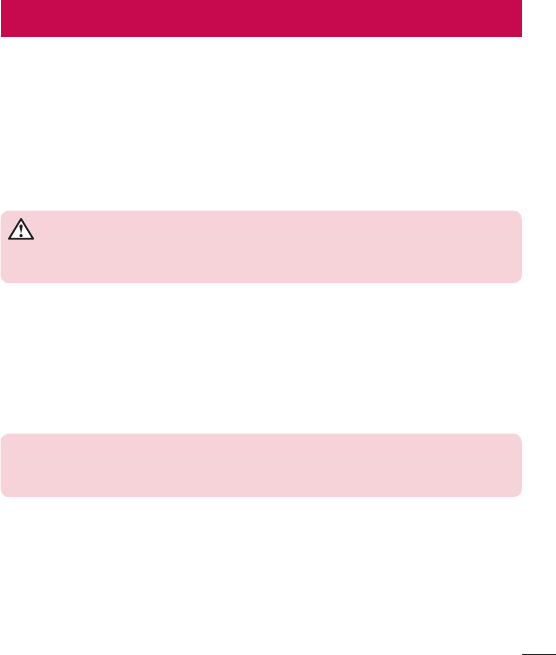
5
Important Information
This user’s guide contains important information about the use and operation of this phone. Read all
information carefully for optimal performance and to avoid any damage or misuse of the phone. Any changes or
modifications not expressly approved in this user’s guide could void your warranty for this equipment.
Before you begin
Safety Guidelines
WARNING
To reduce the possibility of electric shock, do not expose your product to high humidity
areas, such as bathroom or swimming pool.
Keep the phone away from heat. Never store your phone in environment that may expose it to temperatures
below 0°C or above 40°C, such as outdoor during snowstorm, or in your car in hot days. Exposure to cold or
heat will result in malfunction, damage or permanent failure. Be careful when using your phone near other
electronic devices. The RF emissions from mobile phones may affect nearby electronic equipment that not
adequately shielded. You should consult manufacturers of any personal medical devices, as in the case of
pacemakers and hearing aides, to determine whether they are susceptible to interference from cell phones.
Turn off your phone in medical facilities or at gas stations. Never place your phone in microwaves, as it will cause
the battery to explode.
Important!
Before using your phone, please read the SAFETY INFORMATION OF THE
TELECOMMUNICATIONS INDUSTRY ASSOCIATION (TIA).
For your safety

6
Safety Information
Read these simple guidelines. Breaking the rules may be illegal or dangerous.
More detailed information is provided in this user’s guide.
• Never use an unapproved battery that could cause damages to the phone or the battery itself, or even
explode.
• Never place your phone in a microwave oven, as this will result in an explosion of the battery.
• Do not dispose of your battery in fire or with hazardous or flammable materials.
• Make sure the battery does not come into contact with sharp-edged items, such as animal teeth or claws.
This could cause a fire.
• Store the battery in a place out of the reach of children.
• Be careful so that children do not swallow any parts of the phone, such as rubber plugs (earpiece, parts that
connect to the phone, etc.). This could cause asphyxiation or suffocation.
• Disconnect the plug and charger from the outlet when the phone shows that the battery has been fully
charged, because it may cause electric shock or fire hazard.
• When in the car, do not leave your phone, or install a hands-free kit, near the airbag. If wireless equipment is
improperly installed, you can be seriously injured if the airbag is deployed.
• Do not use mobile phone while driving.
• Do not use the phone in areas where its usage is prohibited. (For example: in airplanes).
• Do not expose the battery charger or adapter to direct sunlight, or use it in places with high humidity, such as
bathroom.
• Never store your phone in temperatures lower than -20°C or higher than 50°C.
• Do not use harsh chemicals (such as alcohol, benzene, solvents, etc.) or detergents to clean the phone. This
could cause fire.
• Do not drop the phone, strike it, or shake it hard.
Such actions may harm the phone’s internal circuit boards.
• Do not use your phone in high explosive areas, as this may generate sparks.
• Do not damage the power cord by bending, twisting, pulling, or heating it. Do not use the plug if it is loose as
it may cause fire or electric shock.
• Do not handle the phone with wet hands while it is charging. This can cause electric shock or seriously
damage your phone.
• Do not disassemble the phone.
• Do not make or answer calls while charging the phone, which can cause a short circuit, electric shock, or fire.
For your safety

7
• Use only batteries and chargers provided by LG. The warranty does not apply to products provided by other
providers.
• Only authorized personnel should service the phone and its accessories.
Installation or service may result in accidents and consequently invalidate the warranty.
• Do not hold or let the antenna come in contact with your body during a call.
• Emergency calls can be made only within a service area. To make an emergency call, make sure you are
within a service area and the phone is on.
• Use your accessories, such as headphones or headsets, with caution, ensuring that the cables are plugged
properly and that they do not touch the antenna unnecessarily.
Information about the RF exposure from FCC
WARNING
Read this information before operating the phone.
In August 1996, the Federal Communications Commission (FCC) of the United States, with its action in Report
and Order FCC 96-326, adopted an updated safety standard for human exposure to radio frequency (RF)
electromagnetic
energy emitted by FCC regulated transmitters. Those guidelines are consistent with the safety standard
previously set by both international and U.S. standards.
The design of this phone complies with FCC guidelines and these international standards.
Caution
Use only the supplied antenna. Use of unauthorized antennas, or modifications, could impair call quality, damage
the phone, void your warranty, or result in a violation of FCC regulations.
Do not use the phone with a damaged antenna.
A damaged antenna in contact with the skin could cause a singe. Contact your local dealer for an antenna
replacement.

8
Battery Precautions
• Do not disassemble.
• Do not short-circuit.
• Do not expose to high temperatures, over 60 °C (140 °F).
• Do not incinerate.
For your safety

9
Battery Disposal
• Please dispose of your battery properly, or bring it to your wireless provider for recycling.
• Do not dispose of your battery in fire or with hazardous or flammable materials.
Adapter Precautions (Charger)
• Using the wrong battery charger could damage your phone and void your warranty.
• The adapter or battery charger is only designed for indoor use.
• Do not expose the battery charger or adapter to direct sunlight, or use it in places with high humidity, such as
the bathroom.
Cautions for Battery
• Do not disassemble or open crush, bend or deform, puncture or shred.
• Do not modify or remanufacture, attempt to insert foreign objects into the battery, immerse or expose to water
or other liquids, expose to fire, explosion or other hazard.
• Only use the battery for the system for which it is specified.
• Only use the battery with a charging system that has been qualified with the system per this standard. Use of
an unqualified battery or charger may present a risk of fire, explosion, leakage, or other hazard.
• Do not short circuit a battery or allow metallic conductive objects to contact battery terminals.
• Replace the battery only with another battery that has been qualified with the system per this standard, IEEE-
Std-1725-200x. Use of an unqualified battery may present a risk of fire, explosion, leakage or other hazard.
• Promptly dispose of used batteries in accordance with local regulations.
• Battery usage by children should be supervised.
• Avoid dropping the phone or battery. If the phone or battery is dropped, especially on a hard surface, and the
user suspects damage, take it to a service center for inspection.
• Improper battery use may result in a fire, explosion or other hazard.
• For those host devices that utilize a USB port as a charging source, the host device's user manual shall
include a statement that the phone shall only be connected to products that bear the USB-IF logo or have
completed the USB-IF compliance program.
• Always unplug the charger from the wall socket after the phone is fully charged to save unnecessary power
consumption of the charger.

10
Avoid damage to your ear
• Damage to your hear can occur due to constant exposure to excessive high sound. We, therefore, recommend
that you do not turn on or off the phone near your ear. We also recommend you be reasonable with the music
and volume level.
• If you listen to music, please ensure that the volume level is adequate, so that you are aware of your
surroundings. This is particularly important when attempting to cross a street.
For your safety

11
Safety instructions
TIA's Safety Information
This includes complete security information on wireless phones from TIA (Telecommunications Industry
Association).
It's required, for CTIA Certification, the inclusion in the user manual of text covering pacemakers, hearing aids
and other medical devices. It's encouraged the use of the remaining TIA language when relevant.
Exposure to Radio Frequency Signal
Your wireless handheld portable telephone is a lowpower radio transmitter and receiver. When it is ON, it receives
and also sends out radio frequency (RF) signals.
In August, 1996, the Federal Communications Commissions (FCC) adopted RF exposure guidelines with safety
levels for handheld wireless phones. Those guidelines are consistent with the safety standards previously set by
both U.S. and international standards bodies:
ANSI C95.1 (1992) *
NCRP Report 86 (1986)
ICNIRP (1996)
Those standards were based on comprehensive and periodic evaluations of the relevant scientific literature. For
example, over 120 scientists, engineers, and physicians from universities, government health agencies, and
industry reviewed the available body of research to develop
the ANSI Standard (C95.1).
* American National Standards Institute; National Council on Radiation Protection and Measurements;
International Commission on Non-Ionizing Radiation Protection.
The design of your phone complies with the FCC guidelines (and those standards).
Antenna Care
Use only the supplied or an approved replacement antenna. Unauthorized antennas, modifications, or
attachments could damage the phone and may violate FCC regulations.

12
Safety instructions
Phone Operation
NORMAL POSITION: Hold the phone as you would any other telephone with the antenna pointed up and over
your shoulder.
Suggestions for a more efficient operation
For your phone to operate most efficiently:
• Do not touch the antenna unnecessarily, when the phone is in use. The contact with the antenna affects call
quality, and may cause the phone to operate at a higher power level than otherwise would be need.
• Use your phone in temperatures between 0ºC and 40ºC, if possible. Exposing your phone to extremely low or
high temperatures may result in damage, malfunction, or even explosion.
Driving
Check the laws and regulations related to the use of wireless phones in the areas where you drive. Always obey
these regulations. Also, if using your phone while driving, make sure to:
• Pay full attention to driving; driving safely is your first responsibility;
• Use hands-free operation, if available;
• Pull off the road and park, before making or answering a call, if driving conditions demand so.
Electronic Devices
Most modern electronic equipment is shielded from RF signals.
However, certain electronic equipment may not be shielded against the RF signals from your wireless phone.

13
Pacemaker
The Medical Industry Manufacturers Association recommends a minimum distance of fifteen (15) centimeters,
or six (6) inches, between a handheld wireless phone and a pacemaker, in order to avoid potential interference
between them.
These advices are consistent with independent researches, and with recommendations based on wireless
technology research.
People with pacemakers should:
• ALWAYS keep the phone at least fifteen centimeters (six inches) from their pacemaker, whenever the phone
is turned on;
• Not carry the phone in a shirt pocket;
• Use the ear opposite to the pacemaker, to minimize the potential interference;
• If you have any reason to suspect that interference is taking place, switch off your phone immediately.
Hearing Aids
Some digital wireless phones may interfere with some hearing aids. In the event of such interference, we
recommend that you contact your service provider.
Other Medical Devices
If you use any other personal medical devices, consult your device manufacturer to determine if they are
adequately shielded from external RF energy. Your doctor can help you obtain this information.
Health Care Facilities
Turn off your phone in health care facilities, whenever there are signs asking you to do so. Hospitals or health
care facilities may use equipment that could be sensitive to external RF energy.

14
Safety instructions
Vehicles
RF signals may affect improperly installed or inadequately shielded devices in motor vehicles.
Check with the manufacturer, or its representative, regarding your vehicle.
You should also consult the manufacturer about any equipment that has been added to your vehicle.
Facilities with signs
Turn off the phone in any facility where warning signs request you to do so.
Airplanes
FCC regulations prohibit the use of phones while in the air. Turn off your phone before boarding an airplane.
Blasting Areas
To avoid interfering with blasting operations, turn your phone off when in a 'blasting area' or in areas with signs
that read: 'Turn off two-way radios' . Obey all signs and instructions.
Potentially Explosive Atmosphere
Turn off the phone when in an area with a potentially explosive atmosphere, and obey all signs and instructions.
Sparks in such areas could cause an explosion or fire that could result in personal injury or death.
Areas with a potentially explosive atmosphere are often clearly marked, but not always. Among the potentially
dangerous areas are:
Fueling areas (such as gas stations), areas below deck on boats, facilities where chemical products are
transferred or stored, vehicles using liquefied petroleum gas (as propane or butane), areas where the air contains
chemicals or particles (such as grain, dust or metal powders), and any other areas where you would normally be
advised to turn off your vehicle engine.

15
For vehicles equipped with air bags
Air bags inflate with strong force. Do not place objects in the area over the air bag or in its deployment area,
including wireless equipment, either installed or portable.
Serious injuries could occur if wireless equipment is improperly installed into the car when the air bag inflates.
Safety Information
Read and observe the following information for the safe and proper use of your phone, and to prevent any
damage.
Also, keep the user's guide in an accessible place at all times after reading it.
Charger, Adapter and Battery Security
• The charger and adapter are designed only for indoor use.
• Dispose of your battery properly, or bring it to your wireless provider for recycling.
• The battery doesn’t need to be fully discharged before recharging.
• Only use LG approved chargers that are specifically made for your phone model, since they are designed to
maximize the battery life.
• Do not disassemble or short-circuit it.
• Replace the battery when it no longer provides acceptable performance. The battery can be recharged several
hundred times before replacement.
• Charge the battery after long periods without use to maximize its life.
• The battery life will vary depending on usage patterns and environmental conditions.
• Intensive use of backlighting, browser, and packet data connectivity affect battery life and talk/standby times.
• The role of self-protection interrupts the phone when its operation is in an abnormal state. In this case, remove
the battery from the phone, reinstall it, and turn on the phone.

16
Safety instructions
Explosion, Shock and Fire Danger
• Do not place the phone in a place exposed to excessive dust, and keep the minimum required distance
between the power cord and heat sources.
• Unplug the power cord before cleaning the phone, and clean the power plug whenever it is dirty.
• When using the power plug, make sure it is firmly connected. Otherwise, it can overheat or start a fire.
• Placing the phone in a pocket or bag without covering the receptacle (power plug pin), metallic articles (such
as a coin, clip or pen) may short-circuit the phone. Always cover the receptacle when not in use.
• Do not short-circuit the battery. Metal items, such as coins, paper clips, or pens, in your pocket or bag may
cause a shortcircuit between the + and - terminals of the battery (metal strips on the battery). The short-
circuit of the terminals may damage the battery and cause an explosion.
General Notice
• Using a damaged battery, or inserting it into the mouth can cause serious injuries.
• Do not place the phone in proximity to items containing magnetic components, such as credit cards, calling
cards, bank books, or subway tickets. The phone magnetism may damage the data stored in the magnetic
strip.
• Talking on the phone for a long period of time may reduce call quality, because of the heat generated during
use.
• When the phone has not been in use for a long time, store it in a safe place, with the power cord unplugged.
• Using the phone close to a receiving equipment (such as TV or radio) may cause interference.
• Do not use the phone if the antenna is damaged. If a damaged antenna contacts skin, it may cause a slight
singe. Contact an LG Authorized Service Facility to replace the damaged antenna.
• Do not immerse your phone in water. If this happens, immediately turn it off and remove the battery. If your
phone does not work, take it to an LG Authorized Service Facility.
• The power supply contains elements that could be harmful to your health, if components are handled directly.
If this happens, we recommend immediate hand-washing.
• Do not paint the phone.
• Data stored in your phone might be deleted due to careless use, hardware repair or software upgrade.
Please backup your important phone numbers (ringtones, text or voice messages, images, and videos might
also get deleted). The manufacturer is not liable for damages due to loss of data.
• When using the phone in public places, you may set the ringer on vibrate to avoid disturbing others.
• Do not switch the phone on/off while it is in your ear.

17
HOW TO UPDATE YOUR SMARTPHONE
Access to latest firmware releases, new software functions and improvements.
• Update your smartphone without a PC. Select Update Center > Software Update.
• Update your smartphone by connecting it to your PC. For more information about
using this function, please visit http://www.lg.com/common/index.jsp select country and
language.
Notice: Open Source Software
To obtain the corresponding source code under GPL, LGPL, MPL and other open source
licences, please visit http://opensource.lge.com/All referred licence terms, disclaimers and
notices are available for download with the source code.

18
Important notice
Please check to see whether any problems you encountered with your phone are described in this section before
taking the phone in for service or calling a service representative.
1. Phone memory
When there is less than 10% of space available in your phone memory, your phone cannot receive new
messages. You need to check your phone memory and delete some data, such as applications or messages, to
make more memory available.
To uninstall applications:
1 Tap > > Apps tab > Settings > General tab > Apps.
2 Once all applications appear, scroll to and select the application you want to uninstall.
3 Tap Uninstall.
2. Optimizing battery life
Extend your battery's power by turning off features that you don't have to run constantly in the background. You
can monitor how applications and system resources consume battery power.
Extending your phone's battery life:
• Turn off radio communications when you are not using. If you are not using Wi-Fi, Bluetooth or GPS, turn them
off.
• Reduce screen brightness and set a shorter screen timeout.
• Turn off automatic syncing for Gmail, Calendar, Contacts and other applications.
• Some applications you have downloaded may reduce battery power.
• While using downloaded applications, check the battery charge level.
To check the battery power level:
• Tap > > Apps tab > Settings > General tab > About phone > Common > Battery.
The battery status (charging or discharging) and battery level (percentage charged) is displayed at the top of the
screen.
Please read this before you start using your phone!

19
To monitor and control how battery power is being used:
• Tap > > Apps tab > Settings > General tab > About phone > Common > Battery > Battery
use.
Battery usage time is displayed on the screen. It tells you how long it has been since you last connected your
phone to a power source or, if currently connected, how long the phone was last running on battery power.
The screen shows the applications or services using battery power, listed in order from the greatest to smallest
amount used.
3. Before installing an open source application and OS
WARNING
If you install and use an OS other than the one provided by the manufacturer it may
cause your phone to malfunction. In addition, your phone will no longer be covered by the
warranty.
WARNING
To protect your phone and personal data, only download applications from trusted
sources, such as Play Store™. If there are improperly installed applications on your
phone, the phone may not work normally or a serious error may occur. You must uninstall
those applications and all associated data and settings from the phone.
4. Using an unlock pattern
Set an unlock pattern to secure your phone. Tap > > Apps tab > Settings > Display tab > Lock
screen > Select screen lock > Pattern. This opens a screen that will guide you through how to draw a screen
unlock pattern. You have to create a Backup PIN as a safety measure in case you forget your unlock pattern.
Caution: Create a Google account before setting an unlock pattern and remember the
Backup PIN you created when creating your pattern lock.

20
WARNING
Precautions to take when using pattern lock.
It is very important to remember the unlock pattern you set. You will not be able to
access your phone if you use an incorrect pattern 5 times. You have 5 opportunities to
enter your unlock pattern, PIN or password. If you have used all 5 opportunities, you can
try again after 30 seconds.
When you can’t recall your unlock Pattern, PIN or Password:
< If you have forgotten your pattern >
If you logged in to your Google account on the phone but failed to enter the correct pattern 5 times, tap the
Forgot pattern? button at the bottom of the screen. You are then required to log in with your Google Account or
you have to enter the Backup PIN which you entered when creating your Pattern Lock.
If you have not created a Google account on the phone or you forgot Backup PIN, you have to perform a hard
reset.
< If you have forgotten your PIN or Password >
If you forget your PIN or Password, you will need to perform a hard reset.
Caution: If you perform a hard reset, all user applications and user data will be deleted.
NOTE: If you have not logged into your Google Account and have forgotten your Unlock
Pattern, you will need to enter your Backup PIN.
5. Using the Hard Reset (Factory Reset)
If your phone does not restore to its original condition, use a Hard Reset (Factory Reset) to initialize it.
1 Turn the power off.
2 Press and hold the Power/Lock Key + Volume Down Key on the phone.
3 Release the Power/Lock Key only when the LG logo is displayed, then immediately press and hold the
Power/Lock Key again.
4 Release all keys when the Factory data reset screen is displayed.
5 Press the Volume Key to scroll to the desired option, then press the Power/Lock Key to confirm.
Important notice

21
WARNING
If you perform a Hard Reset, all user applications, user data and DRM licenses will be
deleted. Please remember to backup any important data before performing a Hard Reset.
6. Opening and switching applications
Multi-tasking is easy with Android, you can keep more than one application running at the same time. There is
no need to quit an application before opening another one. Use and switch between several open applications.
Android manages each application, stopping and starting them as needed to ensure that idle applications don't
consume resources unnecessarily.
1 Touch and hold the Home Key . A list of recently used applications will be displayed.
2 Tap the application you want to access. This does not stop the previous app running in the background on
the phone. Make sure to tap Back Key to exit an app after using it.
• To stop applications, tap Task Manager from the recent apps list, then tap Stop or Stop all.
• To remove an app from the recent apps list, swipe the app preview to the left or right. To clear all apps, tap
Clear all.
7. Transferring music, photos and videos using Media
sync (MTP)
1 Tap > > Apps tab > Settings > General tab > Storage to check out the storage media.
2 Connect the phone to your PC using the USB cable.
3 Select USB connection method will appear on your phone screen, select the Media sync (MTP) option.
4 Open the memory folder on your PC. You can view the mass storage content on your PC and transfer the
files from PC to Device memory folder or vice versa.
8. Hold your phone upright
Hold your cell phone vertically, as you would a regular phone. Your phone has an internal antenna. Be careful not
to scratch or damage the back of the phone, as this may affect performance.
When making/receiving calls or sending/receiving data, avoid holding the lower part of the phone where the
antenna is located. Doing so may affect call quality.

22
9. When the screen freezes
If the screen freezes or the phone does not respond when you try to operate it:
Press and hold the Power/Lock Key for 10 seconds to turn your phone off. If it still does not work, please
contact the service center.
Important notice
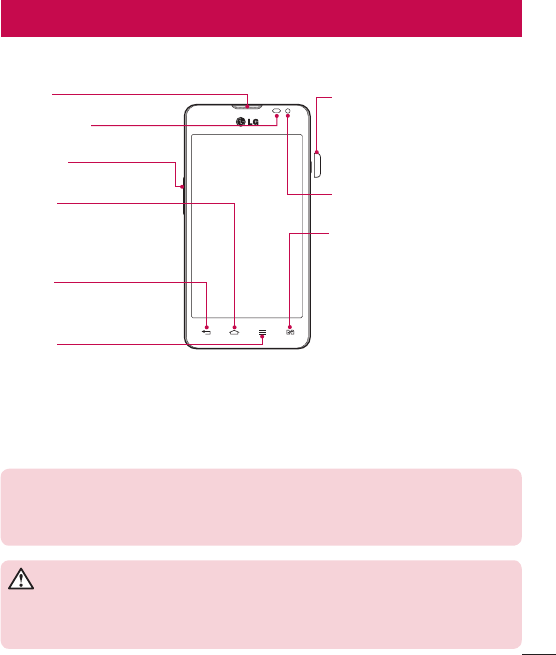
23
Phone overview
Proximity Sensor
Volume keys
Earpiece
SIM Switch Key
Touch the key for SIM1/SIM2 selection
(Selected SIM is marked by Rectangle
box on RSSI icon). Touch and Hold the
key to go to Dual SIM settings.
Home Key
Return to the Home screen from any
screen.
Back Key
• Return to the previous screen.
• Exit an app after using it.
Menu Key
Display the available options.
Power/Lock Key
• Switch your phone on/off by pressing
and holding this key.
• Short press to lock/unlock the screen.
Front-Facing Camera lens
NOTE: Proximity sensor
When receiving and making calls, the proximity sensor automatically turns the backlight off
and locks the touch screen by sensing when the phone is near your ear. This extends battery
life and prevents you from unintentionally activating the touch screen during calls.
WARNING
Placing a heavy object on the phone or sitting on it can damage the LCD and touch screen
functions. Do not cover the LCD proximity sensor with protective film. This could cause the
sensor to malfunction.
Getting to know your phone
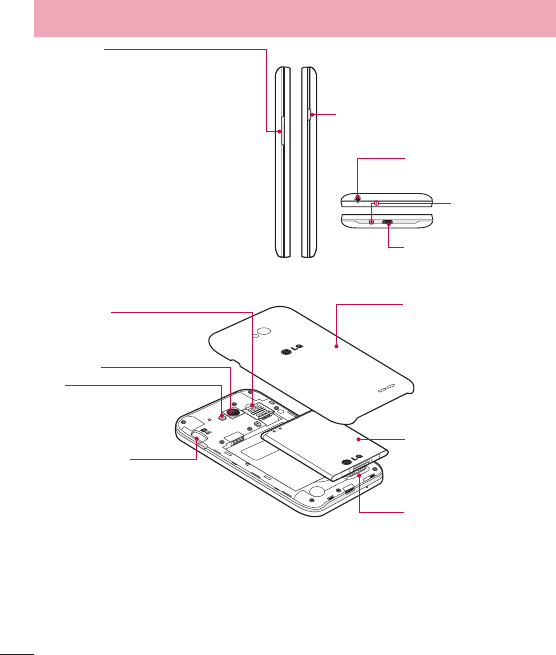
24
Charger/USB Port
Microphone
Earphone Jack
Power/Lock Key
Volume keys
• In the Home screen: Control ringer volume.
• During a call: Control your earpiece volume.
• When playing a song: Control volume
continuously.
Battery cover
Camera lens
microSD Card slot
SIM cards slot
(Upper slot for SIM1 and Lower slot
for SIM2)
Speaker
Battery
Flash
Getting to know your phone
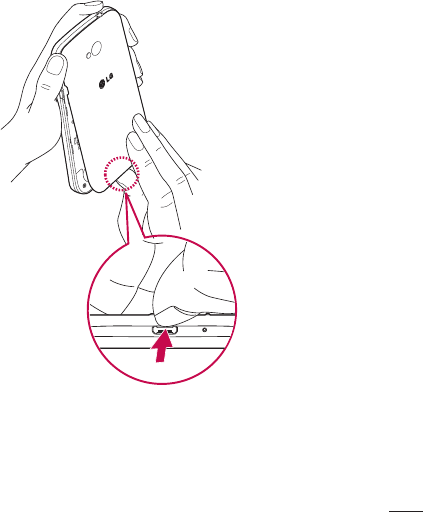
25
Installing the SIM card and battery
Before you can start exploring your new phone, you'll need to set it up. To insert the SIM card and battery.
1 To remove the battery cover, hold the phone firmly in one hand. With your other hand, lift off the battery cover
with your index finger as shown in figure.
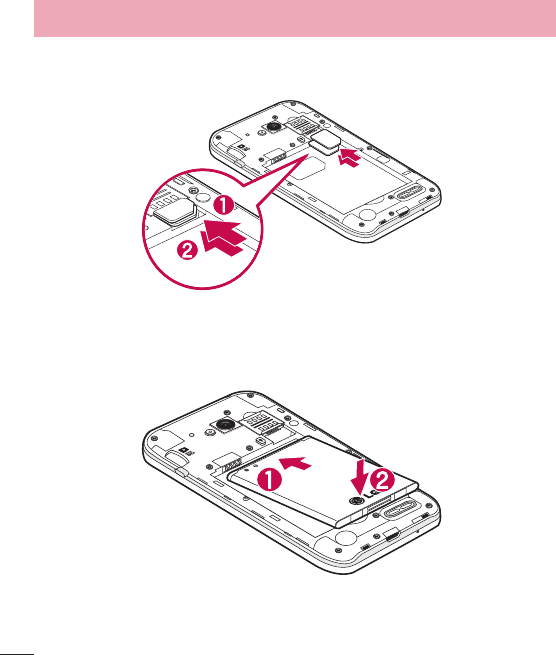
26
2 Slide the SIM card into its slots as shown in the figure. Make sure the gold contact area on the card is
facing downwards.
3 Insert the battery into place by aligning the gold contacts on the phone and the battery (1) and pressing it
down until it clicks into place (2).
Getting to know your phone
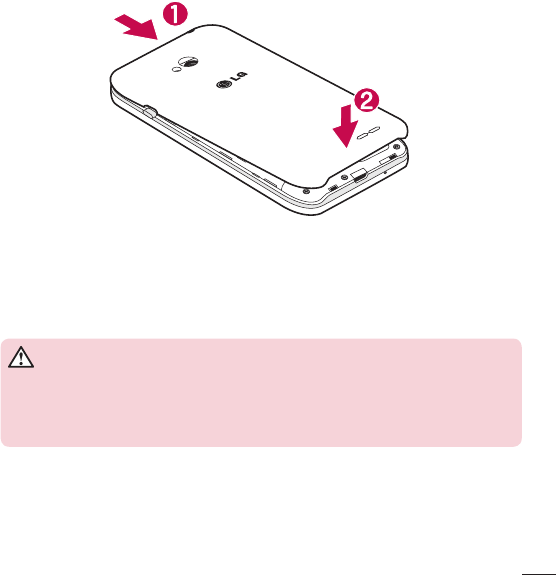
27
4 Align the battery cover over the battery compartment (1) and press it down until it clicks into place (2).
Charging your phone
Charge the battery before using it for the first time. Use the charger to charge the battery. A computer can be
also used to charge the device by connecting them via the USB cable.
WARNING
Use only LG-approved chargers, batteries, and cables. When using unapproved
chargers or cables, it may cause battery charging delay or pop-up message regarding
slow charging. Or, unapproved chargers or cables can cause the battery to explode or
damage the device, which are not covered by the warranty.
The charger connector is at the bottom of the phone. Insert the charger and plug it into an electrical outlet.
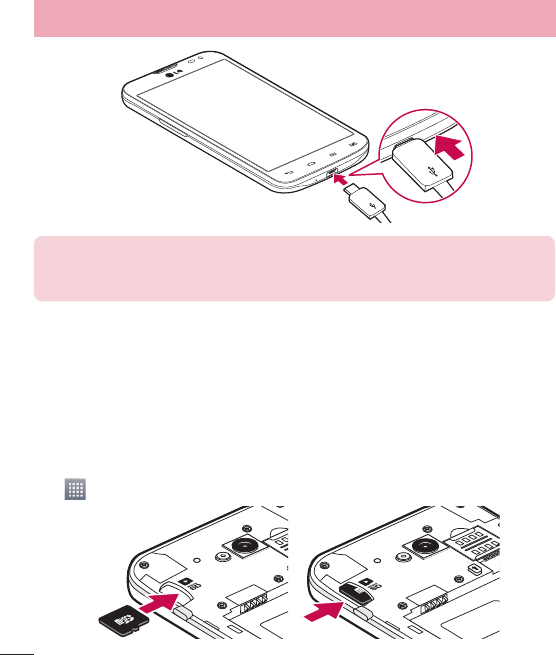
28
NOTE:
• The battery must be fully charged initially to improve battery lifetime.
• Do not open the back cover while your phone is charging.
Using the memory card
Your phone supports the use of microSD
TM
or microSDHC
TM
memory cards of up to 32 GB capacity. These
memory cards are specifically designed for mobile phones and other ultra-small devices, and are ideal for storing
media-rich files such as music, programs, videos, and photographs for use with your phone.
To insert a memory card:
Insert the memory card into the slot. Make sure the gold contact area is facing downwards.
To safely remove the memory card:
Touch > Apps tab > Settings > General tab > Storage > Unmount SD card.
Getting to know your phone
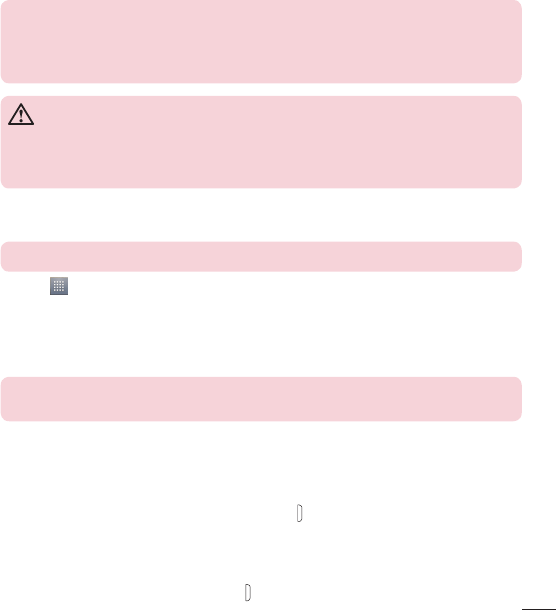
29
NOTE:
• Use only compatible memory cards with your phone. Using incompatible memory cards
may damage the card and data stored on the card, as well as the phone.
• As the device uses FAT32, the maximum size for any given file is 4 GB.
WARNING
Do not insert or remove the memory card when the phone is ON. Doing so may damage
the memory card as well as your phone, and the data stored on the memory card may
become corrupt.
To format the memory card:
Your memory card may already be formatted. If it isn't, you must format it before you can use it.
NOTE: All files on your memory card are deleted when it is formatted.
1 Touch to open the application list.
2 Scroll and touch Settings > General tab > Storage.
3 Touch Unmount SD card.
4 Touch Erase SD card > Erase SD card > Erase everything.
5 If you have set a pattern lock, input the pattern lock then select Erase everything.
NOTE: If there is content on your memory card, the folder structure may be different after
formatting, as all the files will have been deleted.
Locking and unlocking the screen
If you do not use the phone for a while, the screen will be automatically turned off and locked. This helps to
prevent accidental taps and saves battery power.
When you are not using the phone, press the Power/Lock key to lock your phone.
If there are any programs running when you lock your screen, they may be still running in Lock mode. It is
recommended that you exit all programs before entering Lock mode to avoid unnecessary charges (e.g. phone
calls, web access and data communications).
To wake up your phone, press the Power/Lock key . The Lock screen will appear. Touch and slide the Lock
screen in any direction to unlock your Home screen. The last screen you viewed will open.

30
Knock Code
You can unlock the screen when screen is off by taping the correct area and sequence.
To activate Knock Code feature
1 Tap > > Apps tab > Settings > General tab > Lock screen > Select screen lock > Knock
Code.
2 This opens a screen that will guide you through how to select the unlock sequence. You have to create a
Backup PIN as a safety measure in case you forget your unlock sequence.
TIP: Double-tap to turn the screen on when Knock Code is not in use.
KnockON
You can lock or unlock the screen by just double-tap.
To activate KnockON feature
1 Tap > > Apps tab > Settings > General tab > Gestures.
2 Place a checkmark on Screen on/off.
Double-tap the center screen quickly to unlock the screen. To lock the screen, double-tap the status bar in any
screen (except on the camera viewfinder) or empty area on the Home screen.
NOTE: When turning the screen on, make sure you do not cover the proximity sensor.
Doing so will turn the screen off immediately after turning it on in order to prevent
abnormal turning on in your pocket or bag.
Plug & Pop
Plug & Pop allows you to quickly choose apps to use when plugging in an earphone.
1 Plug in earphone.
2 The applications panel will display and you can select an app to run.
NOTE: You can edit the applications to display on the panel and set not to show the
applications panel.
XTap > > Apps tab > Settings > General tab > Accessory > Earphone Plug & Pop.
Getting to know your phone

31
Your Home screen
Touch screen tips
Here are some tips on how to navigate on your phone.
Tap or touch – A single finger tap selects items, links, shortcuts and letters on the on-screen keyboard.
Touch and hold – Touch and hold an item on the screen by tapping it and not lifting your finger until an action
occurs. For example, to open a contact's available options, touch and hold the contact in the Contacts list until
the context menu opens.
Drag – Touch and hold an item for a moment and then, without lifting your finger, move your finger on the
screen until you reach the target position. You can drag items on the Home screen to reposition them.
Swipe or slide – To swipe or slide, quickly move your finger across the surface of the screen, without pausing
when you first tap it (so you don’t drag an item instead). For example, you can slide the screen up or down to
scroll through a list, or browse through the different Home screens by swiping from left to right (and vice versa).
Double-tap – Double-tap to zoom on a webpage or a map. For example, quickly double-tap a section of a
webpage to adjust that section to fit the width of the screen. You can also double-tap to zoom in and out while
viewing the picture.
Pinch-to-Zoom – Use your index finger and thumb in a pinching or spreading motion to zoom in or out when
using the browser or Maps, or when browsing pictures.
Rotate the screen – From many applications and menus, the orientation of the screen adjusts to the device's
physical orientation.
NOTE:
• To select an item, tap the center of the icon.
• Do not press too hard; the tap screen is sensitive enough to pick up a light, yet firm tap.
• Use the tip of your finger to tap the option you want. Be careful not to tap any other
keys.
Home screen
The Home screen is the starting point for many applications and functions, and it allows you to add items like
application shortcuts, or Google widgets to give you instant access to information and applications. This is the
default canvas and accessible from any menu by tapping .
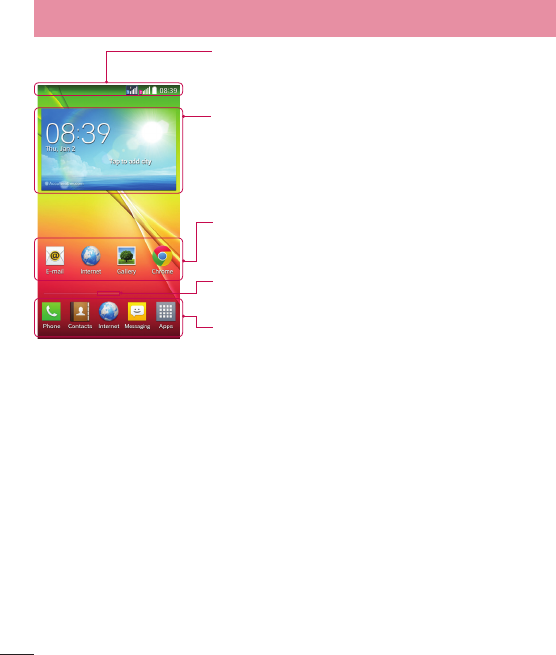
32
Status Bar
Shows phone's status information including the time, signal strength,
battery status, and notification icons.
Widget
Widgets are self-contained applications that can be accessed through
the Apps screen or on the Home screen or an extended home screen.
Unlike a shortcut, the Widget appears as an on-screen application.
Application Icons
Tap an icon (application, folder, etc.) to open and use it.
Location Indicator
Indicates which Home screen canvas you are viewing.
Quick Key Area
Provides one-touch access to the function in any home screen canvas.
Extended home screen
The operating system provides multiple Home screen canvases to provide more space for adding icons, widgets,
and more.
XSlide your finger left or right across the Home screen.
Your Home screen
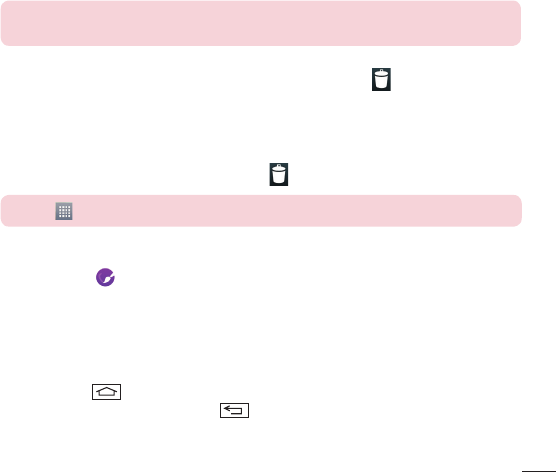
33
Customizing the Home screen
You can customize your Home screen by adding apps, widgets or changing wallpapers.
To add items on your Home screen
1 Touch and hold the empty part of the Home screen.
2 In the Add Mode menu, select the item you wish to add. You will then see this added item on the Home
screen.
3 Drag it to the desired location and lift your finger.
TIP! To add an application icon to the Home screen from the Apps menu, touch and hold
the application you want to add.
To remove an item from the Home screen
XHome screen > touch and hold the icon you want to remove > drag it to .
To add an app as a Quick key
XFrom the Apps menu or on the Home screen, touch and hold an application icon and drag it to the Quick
key area.
To remove an app from the Quick key area
XTouch and hold the desired quick key and drag it to .
NOTE: Apps key cannot be removed.
To customize apps icons on the Home screen
1 Touch and hold an application icon until it is unlocked from its current position. Then drop it on the screen.
The editing icon will appear in the upper right corner of the application.
2 Tap the application icon again and select the desired icon design and size.
3 Tap OK to save the change.
Returning to recently-used applications
1 Touch and hold . The screen displays a pop-up containing the icons of applications you used recently.
2 Tap an icon to open the application. Or tap to return to your previous screen.
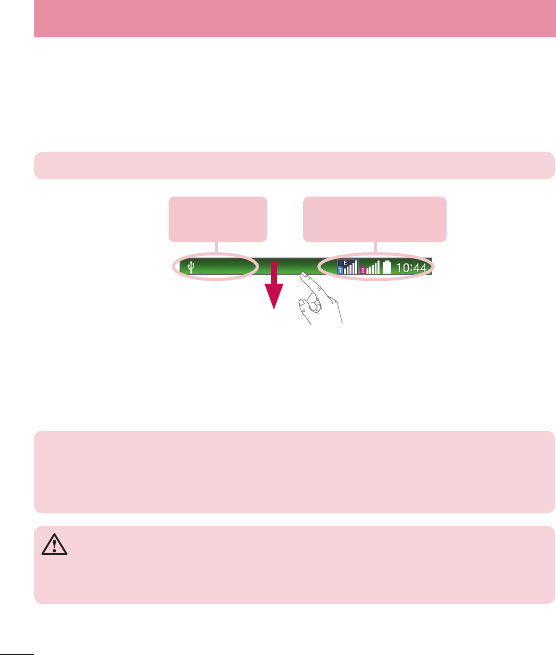
34
Notifications panel
Notifications alert you the arrival of new messages, calendar events, and alarms, as well as to ongoing events,
such as when you are on a call.
When a notification arrives, its icon appears at the top of the screen. Icons for pending notifications appear on
the left, and system icons such as Wi-Fi or battery strength shown on the right.
NOTE: The available options may vary depending on the region or service provider.
Pending
notifications
Bluetooth, Wi-Fi &
battery status
Using Dual SIM
When two SIM cards are inserted on your phone, the SIM cards information are displayed on your notification
drawer. When you touch the SIM switch key, currently active SIM is switched.
NOTE: If only one SIM card is inserted or one SIM is off, SIM switching is not available,
and the SIM switch key has no action. During a call, sending a message or using a data
service, the other SIM’s RSSI might be displayed as ‘No service’ due to the network
service status.
WARNING
If you are outside of the service area, it may cause your device to consume more battery
power.
Your Home screen
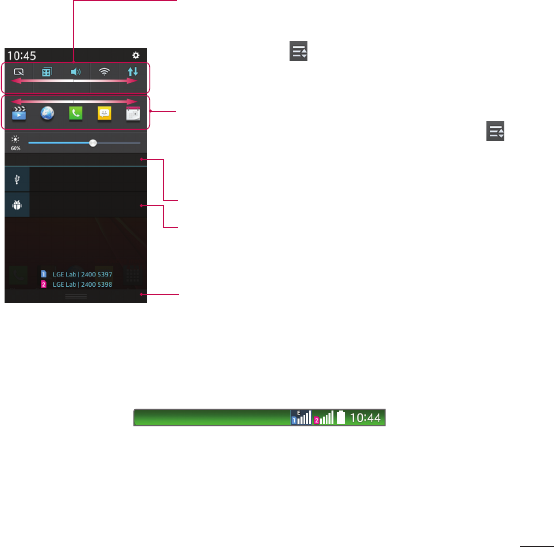
35
Opening the notifications panel
Swipe down from the status bar to open the notifications panel.
Quick Toggle Area
Tap each quick toggle key to turn it on/off. Touch and hold the key to
access the settings menu of the function. To see more toggle keys,
swipe left or right. Tap to remove, add, or rearrange toggle keys.
QSlide Apps
Tap a QSlide app to open as a small window on your screen. Tap to
remove, add, or rearrange QSlide apps.
Tap to clear all the notifications.
Notifications
The current notifications are listed, each with a brief description. Tap a
notification to view it.
To close the notifications panel, touch and drag the tab toward the top
of the screen.
Indicator icons on the Status Bar
Indicator icons appear on the status bar at the top of the screen to report missed calls, new messages, calendar
events, device status and more.
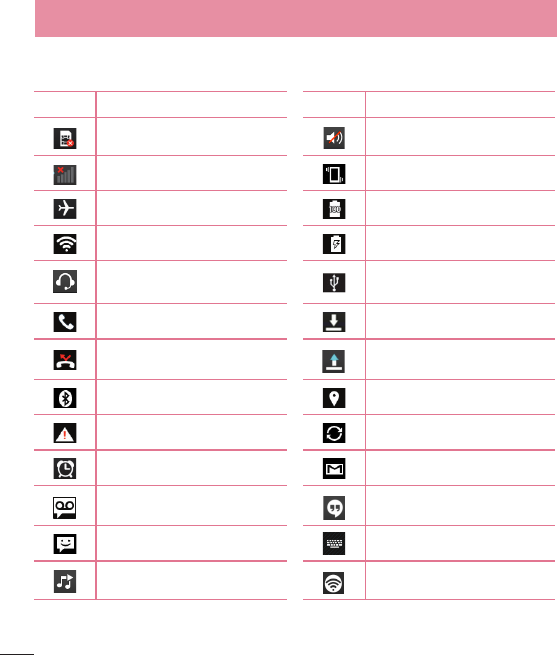
36
The icons displayed at the top of the screen provide information about the status of the device. The icons listed
in the table below are some of the most common ones.
Icon Description Icon Description
No SIM card inserted Ringer is silenced
No network signal available Vibrate mode is on
Airplane mode is on Battery fully charged
Connected to a Wi-Fi network Battery is charging
Wired headset connected Phone is connected to PC via USB
cable
Call in progress Downloading data
Missed call Uploading data
Bluetooth is on GPS is on
System warning Data is synchronizing
An alarm is set New Gmail message available
New voicemail available New Hangouts message available
New text or multimedia message Choose input method
A song is currently playing Mobile hotspot is active
Your Home screen

37
NOTE: The icons location in the status bar may differ according to the function or
service.
On-screen keyboard
You can enter text using the on-screen keyboard. The on-screen keyboard appears automatically on the screen
when you need to enter text. To manually display the keyboard, simply tap a text field where you want to enter
text.
Using the keypad & entering text
Tap once to capitalize the next letter you type. Double-tap for all caps.
Tap to switch to the numbers and symbols keyboard.
Tap to enter a space.
Tap to create a new line.
Tap to delete the previous character.
Entering accented letters
When you select French or Spanish as the text entry language, you can enter special French or Spanish
characters (e.g. "á").
For example, to input "á", touch and hold the "a" key until the zoom-in key grows bigger and displays characters
from different languages.
Then select the special character you want.

38
Google account setup
When you first turn on your phone, you have the opportunity to activate the network, to sign into your Google
Account and select how you want to use certain Google services.
To set up your Google account:
• Sign into a Google Account from the prompted set-up screen.
OR
• Tap > > Apps tab > select a Google application, such as Gmail > select New to create a new
account.
If you have a Google account, tap Existing, enter your email address and password, then tap .
Once you have set up your Google account on your phone, your phone automatically synchronizes with your
Google account on the Web.
Your contacts, Gmail messages, Calendar events and other information from these applications and services on
the Web are synchronized with your phone. (This will depend on your synchronization settings.)
After signing in, you can use Gmail™ and take advantage of Google services on your phone.

39
Connecting to Networks and Devices
Wi-Fi
With Wi-Fi, you can use high-speed Internet access within the coverage of the wireless access point (AP). Enjoy
wireless Internet using Wi-Fi, without extra charges.
Connecting to Wi-Fi networks
To use Wi-Fi on your phone, you need to access a wireless access point or ‘hotspot’. Some access points are
open and you can simply connect to them. Others are hidden or use security features; you must configure your
phone to be able to connect to them.
Turn off Wi-Fi when you're not using it to extend the life of your battery.
NOTE: If you are out of the Wi-Fi zone or have set Wi-Fi to OFF, additional charges may
be applied by your mobile operator for mobile data use.
Turning Wi-Fi on and connecting to a Wi-Fi network
1 Tap > > Apps tab > Settings > Networks tab > Wi-Fi.
2 Set Wi-Fi to ON to turn it on and start scanning for available Wi-Fi networks.
3 Tap the Wi-Fi menu again to see a list of active and in-range Wi-Fi networks.
• Secured networks are indicated by a lock icon.
4 Tap a network to connect to it.
• If the network is secured, you are prompted to enter a password or other credentials. (Ask your network
administrator for details)
5 The status bar displays icons that indicate Wi-Fi status.

40
Bluetooth
You can use Bluetooth to send data by running a corresponding application, but not from the Bluetooth menu as
on most other mobile phones.
NOTE:
• LG is not responsible for the loss, interception or misuse of data sent or received via the
Bluetooth wireless feature.
• Always ensure that you share and receive data with devices that are trusted and
properly secured. If there are obstacles between the devices, the operating distance
may be reduced.
• Some devices, especially those that are not tested or approved by Bluetooth SIG, may
be incompatible with your device.
Turning on Bluetooth and pairing up your phone with a Bluetooth device
You must pair your device with another device before you connect to it.
1 Tap > > Apps tab > Settings > Networks tab > set Bluetooth to ON.
2 Tap the Bluetooth menu again. You will see the option to make your phone visible and option to search
devices. Now tap Search for devices to view the devices in the Bluetooth Range.
3 Choose the device you want to pair with from the list.
Once the paring is successful, your device will connect to the other device.
NOTE: Some devices, especially headsets or hands-free car kits, may have a fixed
Bluetooth PIN, such as 0000. If the other device has a PIN, you will be asked to enter it.
Send data using the Bluetooth wireless feature
1 Select a file or item, such as a contact, calendar event or media file, from an appropriate application or
from Downloads.
2 Select the option for sending data via Bluetooth.
NOTE: The method for selecting an option may vary by data type.
3 Search for and pair with a Bluetooth-enabled device.
Receive data using the Bluetooth wireless feature
1 Tap > > Apps tab > Settings > Networks tab > set Bluetooth to ON.
Connecting to Networks and Devices

41
2 Tap the Bluetooth menu again and mark the checkbox at the top of the screen to make your phone visible
to other devices.
NOTE: To select the length of time that your device will be visible, tap > Visibility
timeout.
3 Select Accept to confirm that you are willing to receive data from the device.
Sharing your phone's data connection
USB tethering and portable Wi-Fi hotspot are great features when there are no wireless connections available.
You can share your phone's mobile data connection with a single computer via a USB cable (USB tethering). You
can also share your phone's data connection with more than one device at a time by turning your phone into a
portable Wi-Fi hotspot.
When your phone is sharing its data connection, an icon appears in the status bar and as an ongoing notification
in the notifications drawer.
For the latest information about tethering and portable hotspots, including supported operating systems and
other details, visit http://www.android.com/tether.
To share your phone's data connection as a portable Wi-Fi hotspot
1 Tap > > Apps tab > Settings > Networks tab > Tethering & networks > Wi-Fi hotspot
switch to activate.
2 Enter a password and tap Save.
TIP! If your computer is running Windows 7 or a recent distribution of some flavours of
Linux (such as Ubuntu), you will not usually need to prepare your computer for tethering.
But, if you are running an earlier version of Windows or another operating system, you
may need to prepare your computer to establish a network connection via USB. For the
most current information about which operating systems support USB tethering and how
to configure them, visit http://www.android.com/tether.
To rename or secure your portable hotspot
You can change the name of your phone's Wi-Fi network name (SSID) and secure its Wi-Fi network.
1 Tap > > Apps tab > Settings > Networks tab > Tethering & networks > Wi-Fi hotspot.
2 Tap Set up Wi-Fi hotspot.
• The Set up Wi-Fi hotspot dialogue box will open.

42
• You can change the Network SSID (name) that other devices see when scanning for Wi-Fi networks.
• You can also tap the Security menu to configure the network with Wi-Fi Protected Access 2 (WPA2)
security using a pre-shared key (PSK).
• If you touch the WPA2 PSK security option, a password field is added to the Set up Wi-Fi hotspot
dialogue box. If you enter a password, you will need to enter that password when you connect to the
phone's hotspot with a computer or other device. You can set Open in the Security menu to remove
security from your Wi-Fi network.
3 Tap Save.
ATTENTION! If you set the security option as Open, you cannot prevent unauthorised
usage of online services by other people and additional charges may be incurred. To
avoid unauthorized usage, you are advised to keep the security option active.
Wi-Fi Direct
Wi-Fi Direct supports a direct connection between Wi-Fi enabled devices without an access point. Due to the
high battery usage of Wi-Fi direct, it is recommended that you plug your phone into a power outlet while using
the Wi-Fi Direct feature. Check your Wi-Fi & Wi-Fi Directed network in advance and make sure the users are
connected to the same network.
PC connections with a USB cable
Learn to connect your device to a PC with a USB cable in USB connection modes.
Transferring music, photos and videos using the USB mass storage mode
1 Connect your phone to a PC using a USB cable.
2 If you haven't installed the LG Android Platform Driver on your PC, you will need to manually change the
settings. Choose System settings > General tab > PC connection > Select USB connection method,
then select Media sync (MTP).
3 You can now view the mass storage content on your PC and transfer the files.
Synchronize with Windows Media Player
Ensure that Windows Media Player is installed on your PC.
1 Use the USB cable to connect the phone to a PC on which Windows Media Player has been installed.
2 Select the Media sync (MTP) option. When connected, a pop-up window will appear on the PC.
Connecting to Networks and Devices

43
3 Open Windows Media Player to synchronize music files.
4 Edit or enter your device’s name in the pop-up window (if necessary).
5 Select and drag the music files you want to the sync list.
6 Start synchronization.
• The following requirements must be satisfied to synchronize with Windows Media Player.
Items Requirement
OS Microsoft Windows XP SP2, Vista or higher
Window Media Player version Windows Media Player 10 or higher
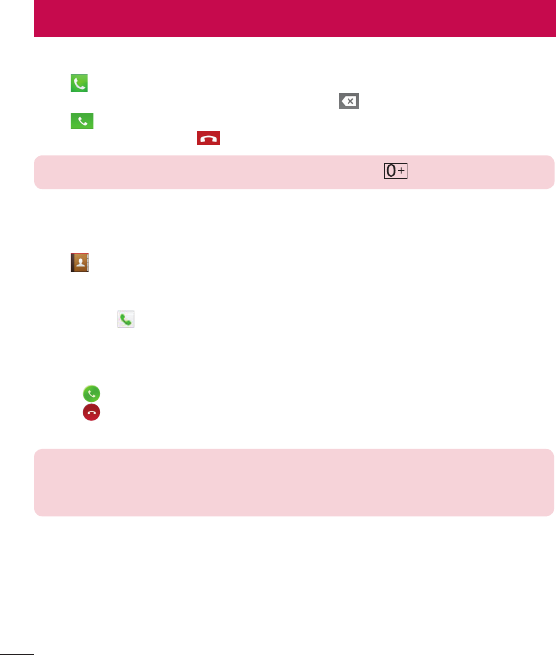
44
Calls
Making a call
1 Tap to open the keypad.
2 Enter the number using the keypad. To delete a digit, tap the .
3 Tap to make a call.
4 To end a call, tap the End icon .
TIP! To enter "+" to make international calls, touch and hold .
Calling your contacts
1 Tap to open your contacts.
2 Scroll through the contact list or enter the first few letters of the contact you want to call by tapping Search
contacts.
3 In the list, tap you want to call.
Answering and rejecting a call
Swipe the in any direction to Answer the incoming call.
Swipe the in any direction to Decline an incoming call.
Swipe the Decline with message icon in any direction if you want to send a message.
TIP! Decline with message
You can send a message quickly using this function. This is useful if you need to reject a
call with message during a meeting.
Adjusting the in-call volume
To adjust the in-call volume during a call, use the Volume up and down keys on the left side of the phone.
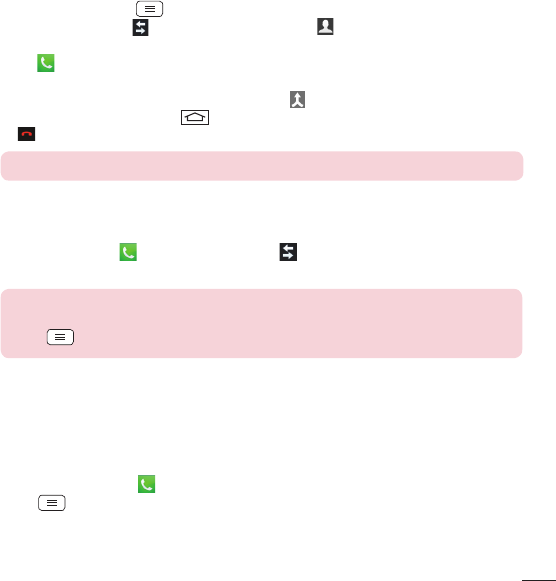
45
Making a second call
1 During your first call, tap > Add call and dial the number. You can also go to the recently dialled
numbers list by tapping or can search contacts by tapping and selecting the contact you want to
call.
2 Tap to make the call.
3 Both calls are displayed on the call screen. Your initial call is locked and put on hold.
4 Tap the displayed number to toggle between calls. Or tap Merge calls to start a conference call.
5 To end active calls, tap End or tap and slide the notification bar down and select the End call icon
.
NOTE: You are charged for each call you make.
Viewing your call logs
On the Home screen, tap and choose the Call logs tab .
View a complete list of all dialled, received and missed calls.
TIP!
• Tap any call log entry to view the date, time and duration of the call.
• Tap , then tap Delete all to delete all the recorded items.
Call settings
You can configure phone call settings such as call forwarding, as well as other special features offered by your
carrier.
1 On the Home screen, tap .
2 Tap .
3 Tap Call settings and choose the options that you wish to adjust.
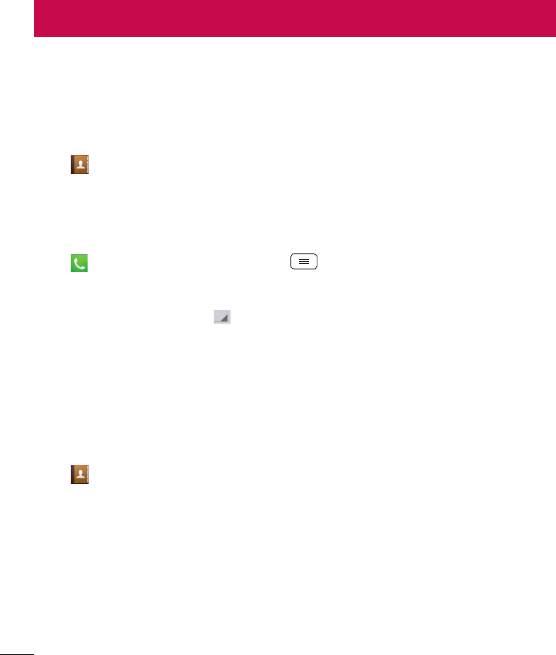
46
Contacts
Add contacts to your phone and synchronize them with the contacts in your Google account or other accounts
that support contact syncing.
Searching for a contact
On the Home screen
1 Tap to open your contacts.
2 Tap Search contacts and enter the contact name using the keyboard.
Adding a new contact
1 Tap , enter the new contact's number, then tap . Tap Add to Contacts > New contact.
2 If you want to add a picture to the new contact, tap the image area.
Choose from Take photo, Select from Gallery.
3 Select the contact type by tapping .
4 Tap a category of contact information and enter the details about your contact.
5 Tap Save.
Favourites contacts
You can classify frequently called contacts as favourites.
Adding a contact to your favourites
1 Tap to open your contacts.
2 Tap a contact to view its details.
3 Tap the star to the right corner of the contact's name. The star will turn yellow color.

47
Removing a contact from your favourites list
1 Tap to open your contacts.
2 Tap the tab, and choose a contact to view its details.
3 Tap the yellow color star to the right corner of the contact's name. The star turns grey color and the contact
is removed from your favourites.
Creating a group
1 Tap to open your contacts.
2 Tap Groups and tap . Select New group.
3 Enter a name for the new group. You can also set a ringtone for the newly created group.
4 Tap Save to save the group.
NOTE: If you delete a group, the contacts assigned to that group will not be lost. They
will remain in your contacts.
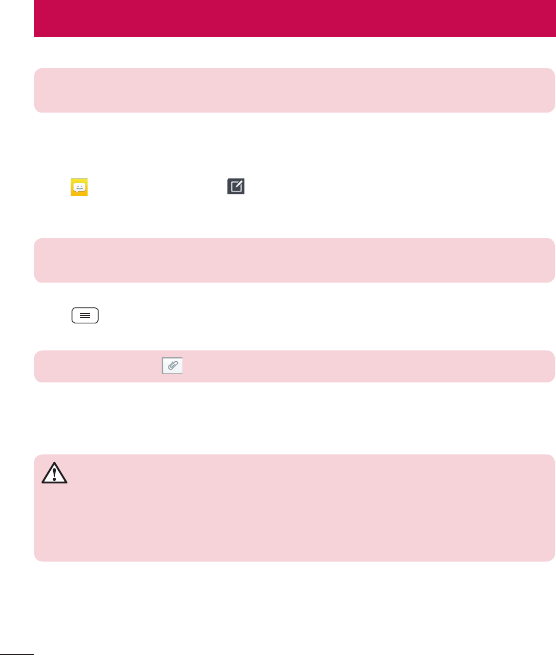
48
Messaging
Your phone combines SMS and MMS into one intuitive, easy-to-use menu.
WARNING: LG message should be set up to default SMS app. If not, some message
functions will be limited.
Sending a message
1 Tap on the Home screen and tap to open a blank message.
2 Enter a contact name or contact number in the To field. As you enter the contact name, matching contacts
will appear. You can tap a suggested recipient. You can add more than one contact.
NOTE: You will be charged for a text message for every person to whom you send the
message.
3 Tap the Message via SIM1/SIM2 field and begin composing your message.
4 Tap to open the Options menu. Choose from Quick message, Insert smiley, Schedule sending,
Add subject and Discard.
TIP! You can tap the icon to attach the file, that you want to share with message.
5 Tap Send to send your message.
6 Responses will appear on the screen. As you view and send additional messages, a message thread is
created.
WARNING:
• The 160-character limit may vary from country to country, depending on the language
and how the SMS is coded.
• If an image, video or audio file is added to an SMS message, it is automatically
converted into an MMS message and you are charged accordingly.

49
Threaded box
Messages (SMS, MMS) exchanged with another party can be displayed in chronological order so that you can
conveniently see an overview of your conversation.
Changing your message settings
Your phone message settings are pre-defined, so you can send messages immediately. You can change the
settings according to your preferences.
• Tap the Messaging icon on the Home screen, tap and then tap Settings.